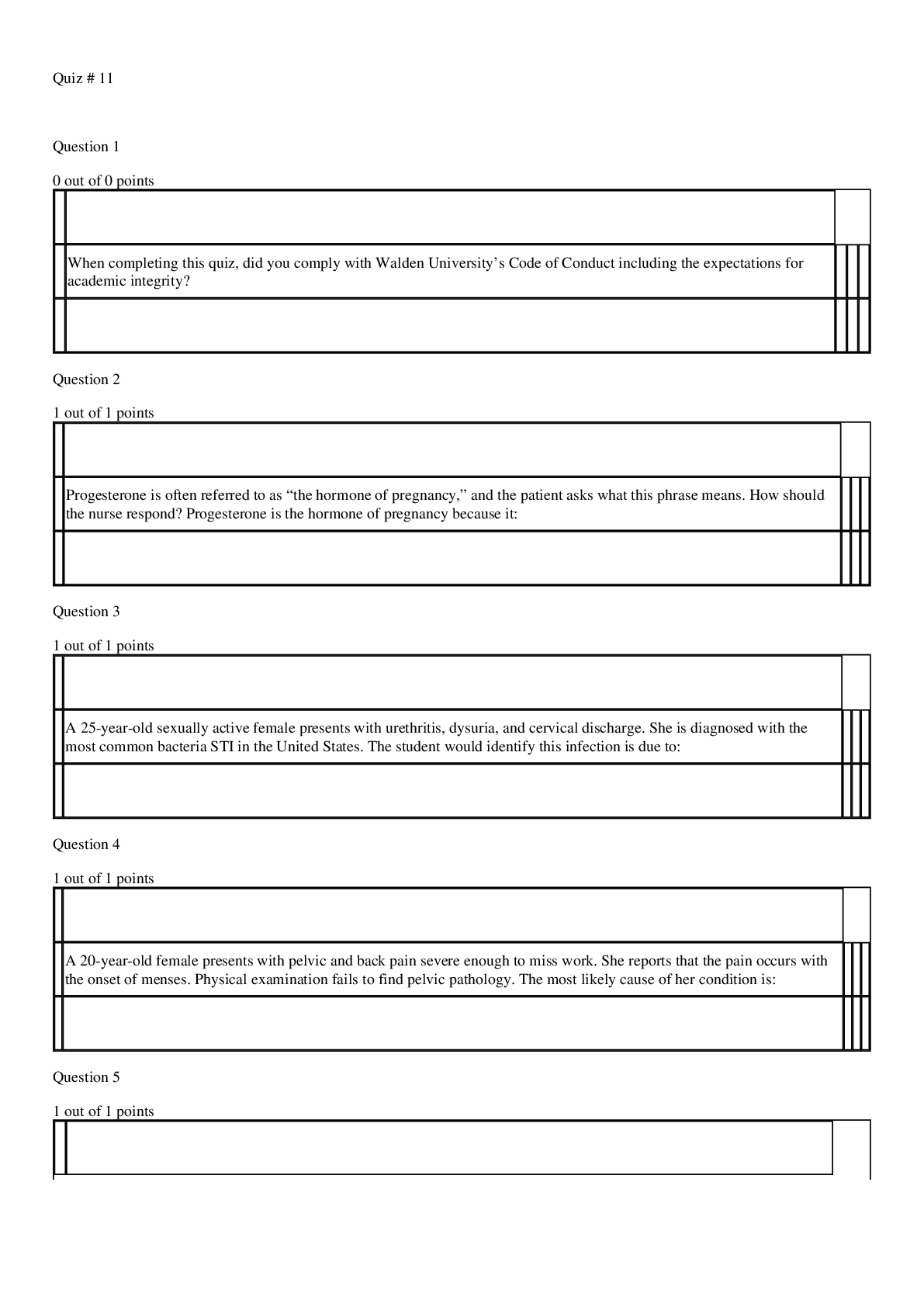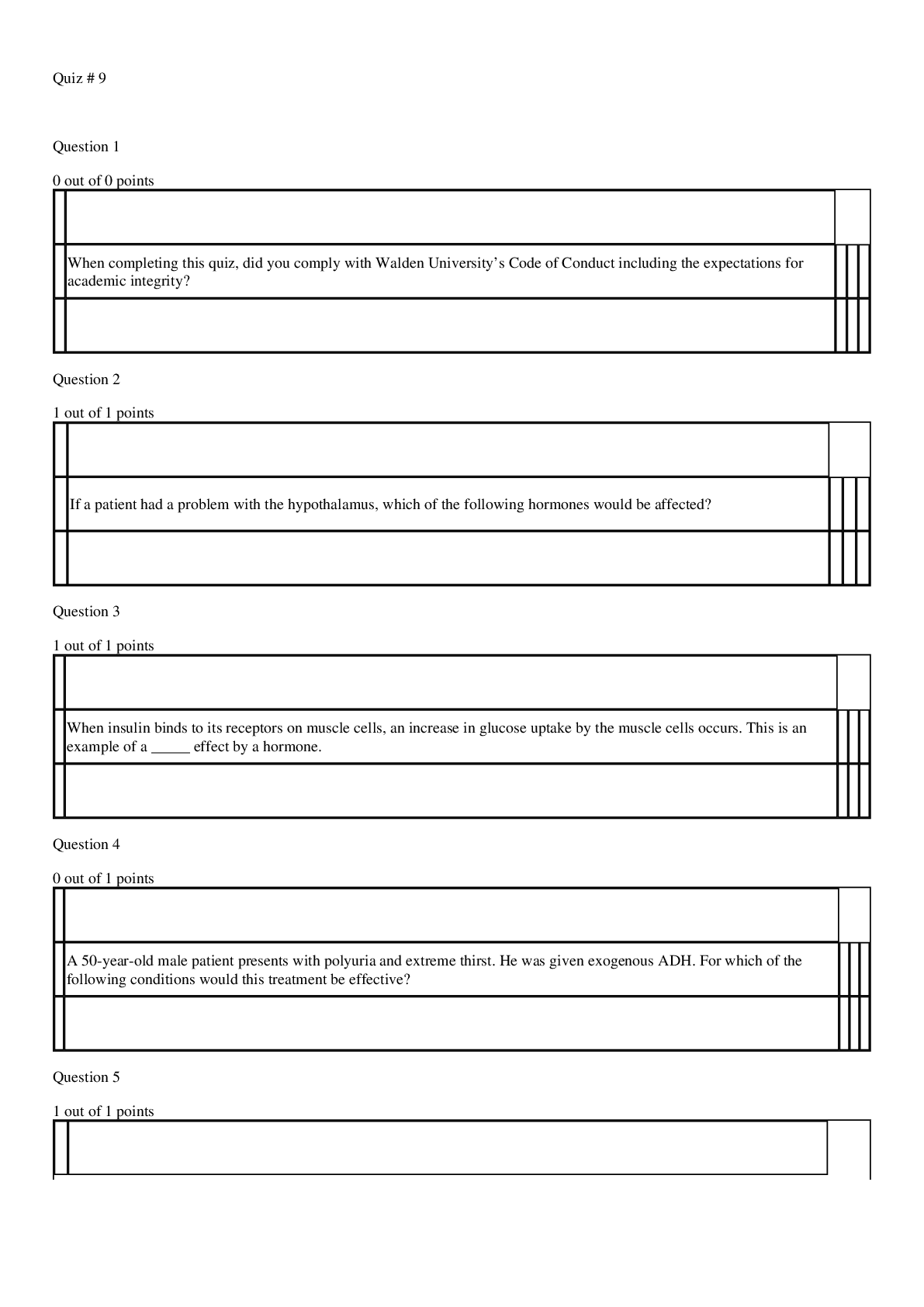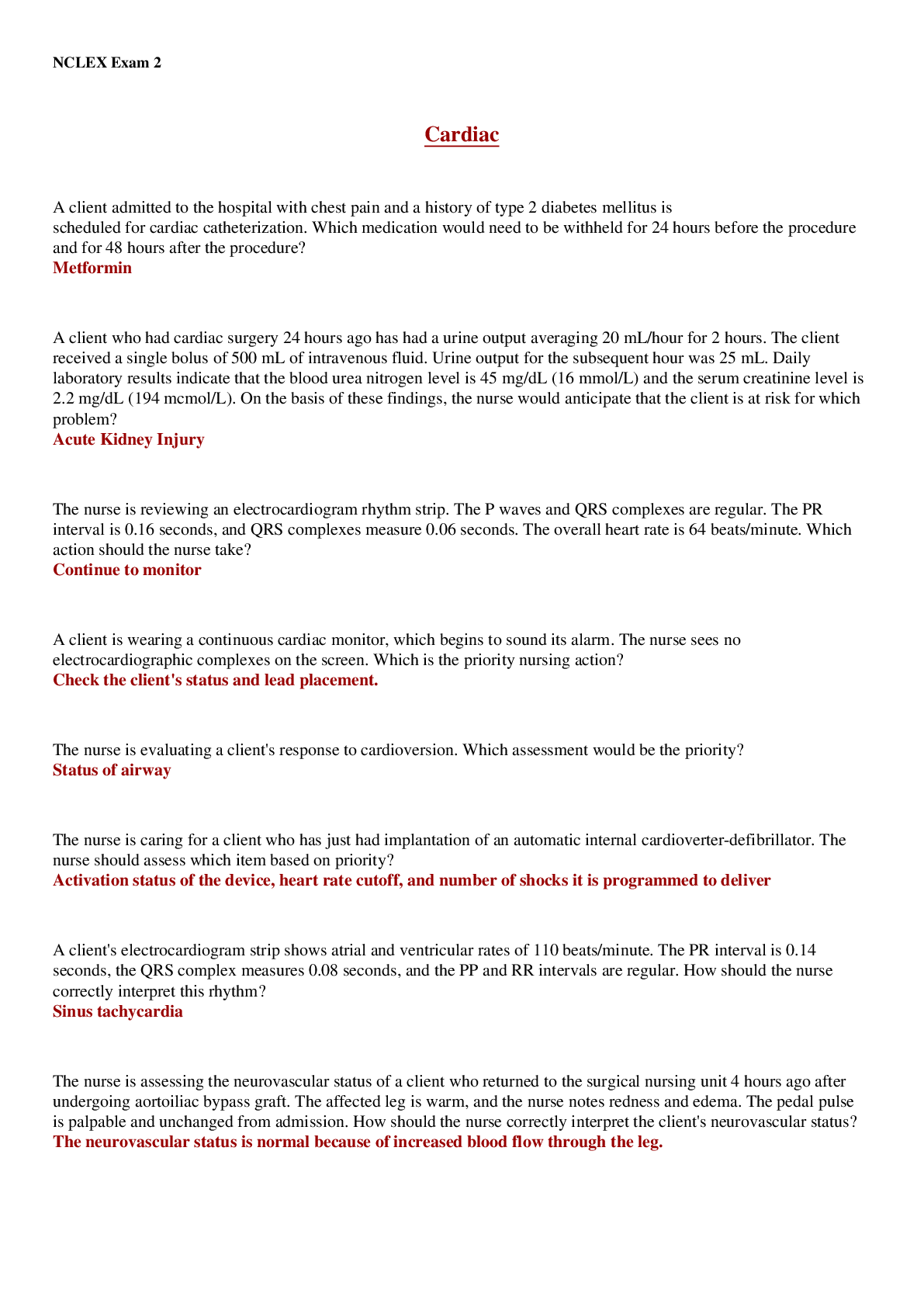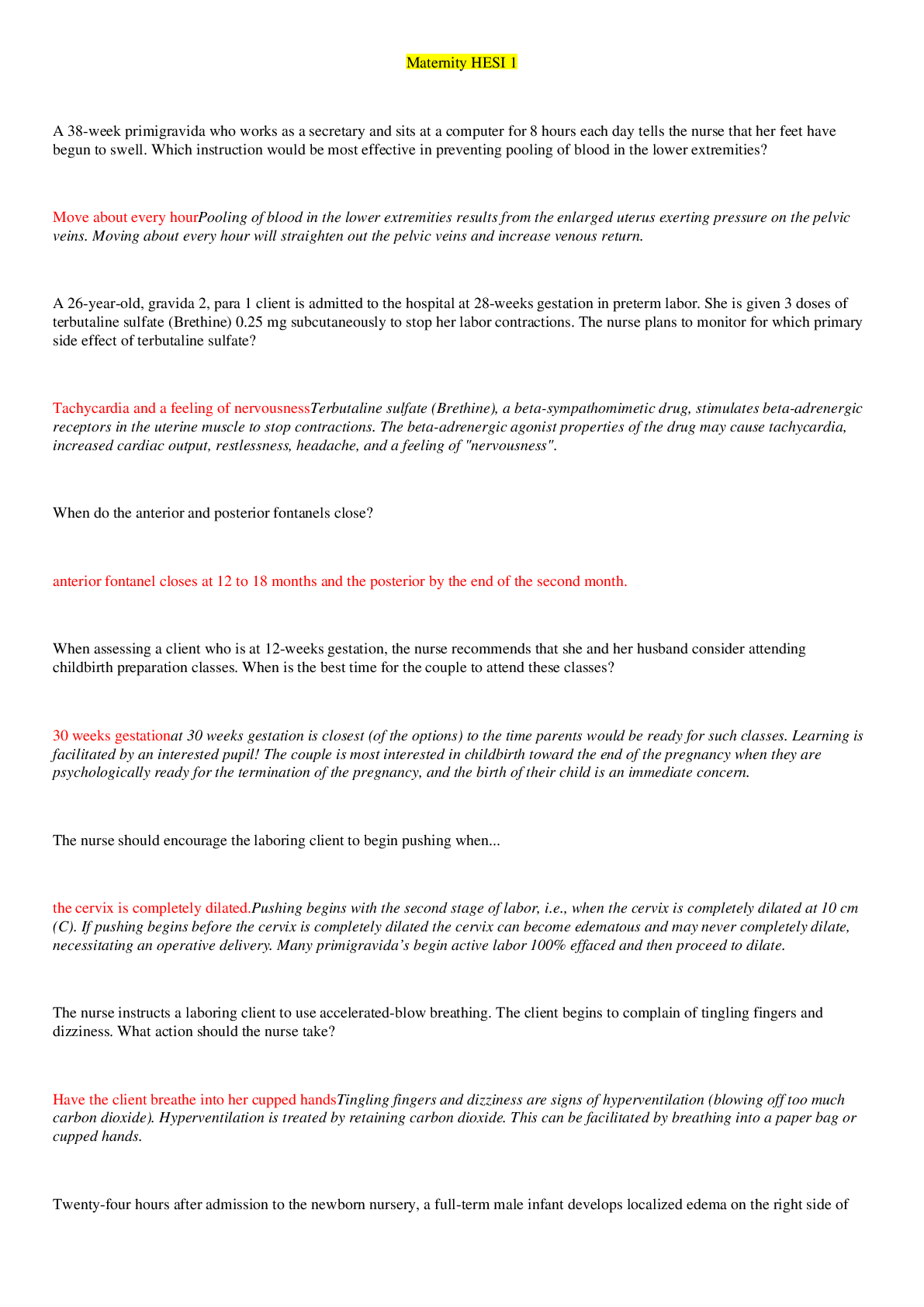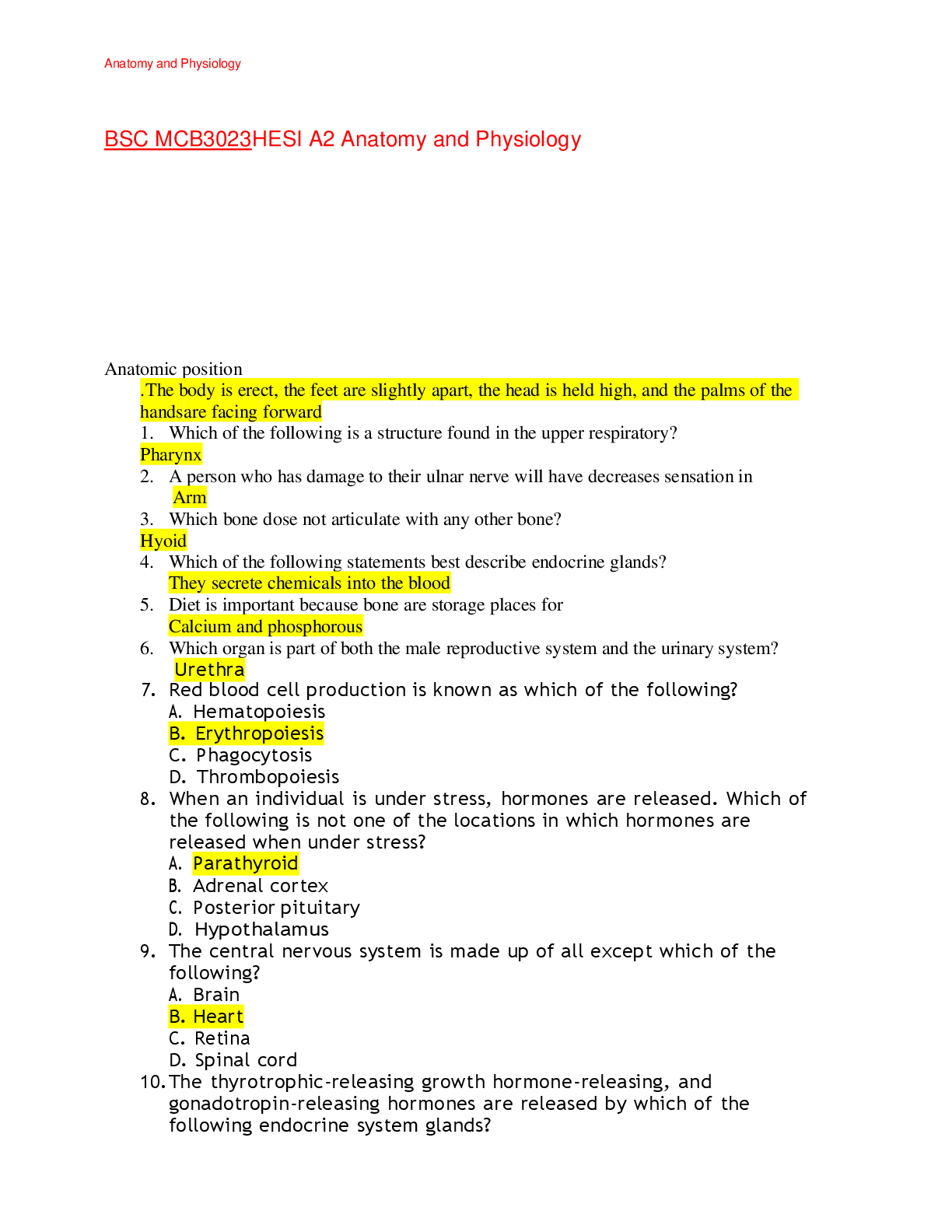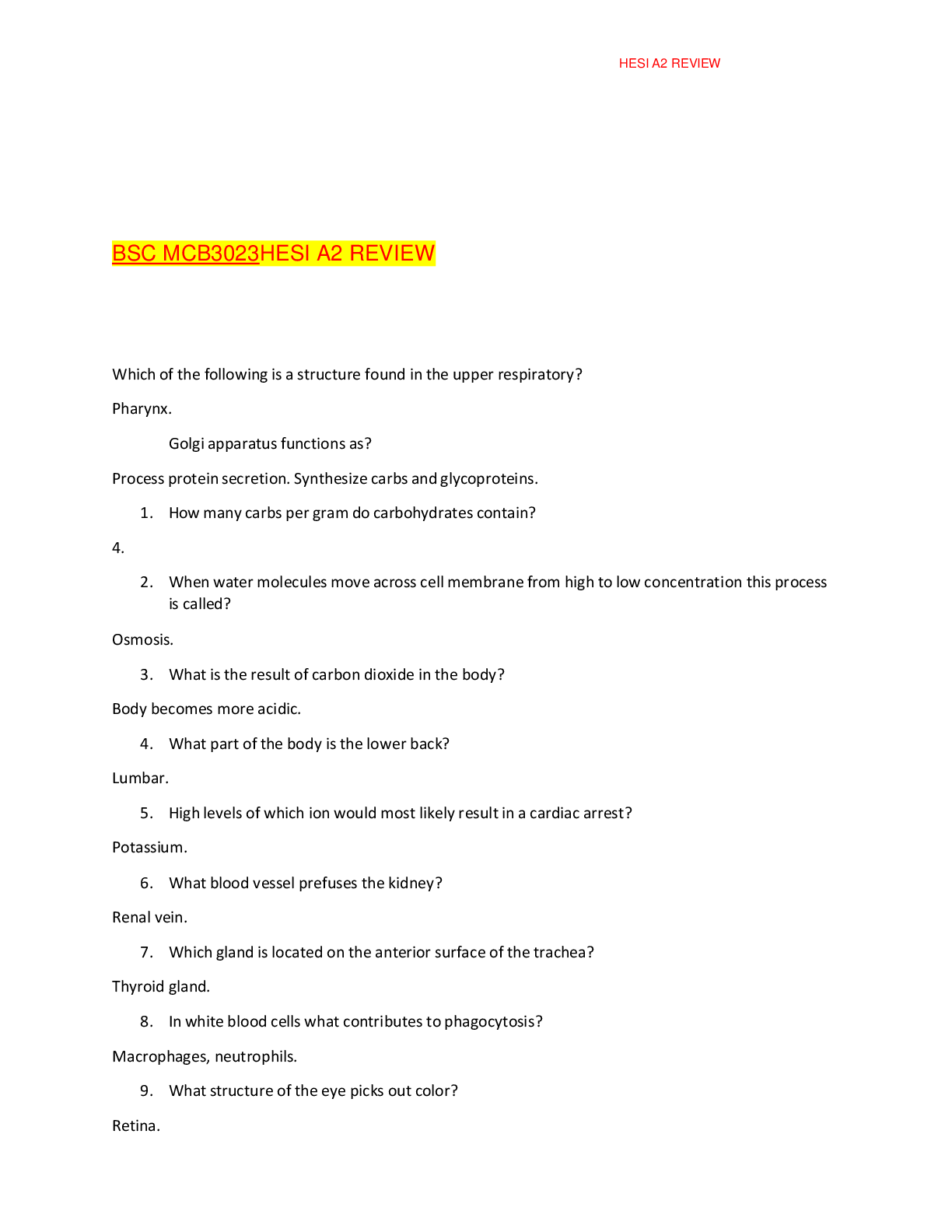Health Care > HESI > NRNP 6640 / NRNP6640 final exam (All)
NRNP 6640 / NRNP6640 final exam
Document Content and Description Below
• Question 1 Linda is a 65-year-old patient who has completed initial treatment for alcohol addiction and anxiety problems. She is motivated to continue her treatment gains and have a healthy lif ... estyle. How would the PMHNP apply a mindfulness approach to this case? • Question 2 A PMHNP is assessing a 60-year-old patient named Carlos. He has severe PTSD and mild substance abuse issues. The most appropriate setting to treat Carlos would be a _________. • Question 3 The PMHNP is interviewing a patient with a history of substance abuse. He has attempted to stop abusing drugs three times before. He states to the PMHNP, “I just cannot change. How can you help me?!” As it applies to change, the PMHNP understands the principle of evocation to mean: • Question 4 The PMHNP is assessing a 30-year-old client who reports feeling stressed out due to his current employment situation. When asked about how he manages this work-related stress, the patient says that exercise helps him feel less anxious, so he often spends 2 or more hours at the gym each night. After completing the patient assessment, the PMHNP has determined that an existential psychotherapy approach may best benefit this client. What is the PMHNP’s goal in employing this treatment approach? • Question 5 The PMHNP initiates feeling-state therapy to help a 25-year-old patient named Monique who has a compulsive urge to exercise. Using the Feeling-State Addiction Protocol, what is an appropriate next step the PMHNP should take after identifying the specific positive feeling linked with the addictive behavior and its Positive Feeling Score level? • Question 6 The PMHNP uses the Adult Attachment Interview (AAI) with a male patient who reports having had a difficult time being separated from his parents during his childhood. He explains that going to school or visiting his relatives without his parents was troublesome. The PMHNP characterizes the patient as unresolved/disorganized, according to his outcomes on the AAI. What does the PMHNP anticipate from the patient? • Question 7 A PMHNP is using motivational interviewing (MI) with a 50-year-old patient named Dave to commit to a healthy drug-free lifestyle. By using “change talk,” the PMHNP hopes to help the patient build self-esteem and hope. True or false: If Dave is resisting change, the PMHNP should challenge his resistance in order for MI to be successful. • Question 8 1 out of 1 points A PMHNP is using emotion-focused therapy to help a 38-year-old patient who says, “I’ve been feeling angry lately, but I’m not sure why.” The first attempt by the PMHNP is to say: • Question 9 The PMHNP is actively listening to Ms. Thomas who is detoxing from alcohol. Ms. Thomas is currently discussing with the PMHNP the reasons why she feels guilty about her drinking. Ms. Thomas tearfully states, “I have driven my family and friends away with this terrible habit. I have no one left. I had more than enough chances and now my children won’t even talk to me.” Which of the following statements demonstrate a simple reflection? 1 out of 1 points • Question 10 The PMHNP is caring for a geriatric patient who expresses symptoms of gastrointestinal problems, aches and pains, and loss of appetite. The patient reports feeling lonely, as more of his friends have been passing away over the recent months and years. The PMHNP focuses on which therapeutic approach for this patient? • Question 11 1 out of 1 points The PMHNP is caring for an adult male patient whose wife left him several months ago. He recently learned that his ex-wife is dating someone much younger. The man feels belittled, sad, and lonely. He talks about trying to meet other women, but says, “I can’t compete with the younger guys these days, with the cool clothes and the vegan diets. I’m bald and overweight, and what woman is going to want to be with me?” How does the PMHNP help raise the man’s self-esteem? • Question 12 The PMHNP is initiating a plan of care for a patient who requires comprehensive psychotherapy to manage his depression and mood disorder. Throughout the initial sessions, the patient reports feeling as though he cannot be helped. The PMHNP is concerned about premature termination initiated by the patient. What strategy can the PMHNP employ to prevent or reduce premature termination? 1 out of 1 points • Question 13 The PMHNP is caring for an older adult patient who is in the acute phase of schizophrenia. Which therapeutic model will the PMHNP employ with this patient? • Question 14 The PMHNP uses the cognitive behavioral therapy model with Gerald, an older adult patient who is being treated for depression and mood disorder. What will the PMHNP do with the patient during the first three sessions? 1 out of 1 points A PMHNP has been treating a 9-year-old patient who was referred by her school. Students are asked to raise their hands before speaking during group discussion, but the patient seems to blurt out what she wants to say without being called on. She also interrupts other children while they are talking instead of waiting her turn. When the patient gets frustrated, she has trouble controlling her emotions and cries often. Based on the initial information provided, the first focus by PMHNP is the child’s ____________. • Question 16 The PMHNP is working with a patient who describes having a painful and traumatic childhood experience, which causes her to have anxiety as an adult. When asked how she manages her anxiety, the patient dismisses it and denies that it is a problem. Using the supportive psychotherapy approach, the PMHNP will do which of the following when assessing the patient’s ego strength? • Question 17 When recalling the phases of change, the PMHNP demonstrates “open questioning” in the “engagement” phase by making which statement? 1 out of 1 points A PMHNP is using Gestalt therapy to communicate with a 42-year-old patient who is upset with her mother. She says, “I want to tell her how hurt I feel when she doesn’t call me, but I don’t want to upset her.” What technique can the PMHNP use to help Sasha express herself? • Question 19 The PMHNP is terminating treatment for a patient who has been receiving eye movement desensitization and reprocessing (EMDR) therapy. What action does the PMHNP take at the final session to terminate treatment? • Question 20 The PMHNP is assessing an older adult male patient with depression and comorbidities. According to the medical chart, the patient takes medication to manage joint and bone pain. The patient reports feeling “forgetful” and complains that he has a hard time remembering where he puts things. What is the primary action by the PMHNP? • Question 21 The PMHNP assesses a 27-year-old patient named Jeff, who was a victim of child abuse and neglect. Jeff says that he remembers a traumatic situation that he wants to share, but is having trouble talking about it. Which statement made by the PMHNP demonstrates the use of emotion-focused therapy? • Question 22 The PMHNP is interviewing a patient who is in the process of successfully completing a substance abuse program. During the interview, the patient states, “I wish I was strong enough to keep the same friends I had before I came here for treatment. I’m really afraid of being discharged because I’ll probably run into my old friends again.” The PMHNP offers a complex reflection when she states the following: • Question 23 The PMHNP continues to meet with Gerald, who is the patient with depression and mood disorder. The PMHNP uses the CBT approach. Gerald is now meeting with the PMHNP for his fifth session and feels comfortable with how the therapy works. What does the PMHNP plan to do with Gerald over the course of the next several sessions? • Question 24 When completing this exam, did you comply with Walden University’s Code of Conduct including the expectations for academic integrity? • Question 25 The PMHNP is terminating treatment with a patient who is aggressive and has a history of anger. What does the PMHNP do when terminating treatment with this patient? • Question 26 The PMHNP is meeting with an older, female adult patient and her daughter. The patient has early onset dementia. The daughter expresses concern, saying, “I don’t want you to just stick my mother in a home and give her medicine. I’m worried that’s what people are going to want to do.” What is the best response by the PMHNP to the daughter? • Question 27 1 out of 1 points The PMHNP meets with a 31-year-old woman who reports feeling as though she is “at her breaking point” with work. The PMHNP learns that the woman works 12-hour days, including one day on the weekend, because she is nervous about company layoffs. “I feel like I need to work myself to death in order to prove that I am valuable to the organization,” the woman says. Using the supportive psychodynamic therapy approach, how does the PMHNP respond? 1 out of 1 points A 38-year-old patient tells the PMHNP that her father went to jail for selling drugs when she was a child. The patient is visibly upset when discussing what happened. Using a humanistic-existential approach to psychotherapy, which of the following is the most appropriate response by the PMHNP? 1 out of 1 points • Question 29 The PMHNP who practices motivational interviewing understands its relationship to patient behaviors and/or outcomes to mean which of the following? • Question 30 A PMHNP has been treating a 14-year-old patient using interpersonal psychotherapy. The patient has been depressed since the death of his grandmother. To help the patient recover, the PMHNP has told the parents: • Question 31 A PMHNP is treating a 25-year-old patient who has a compulsive urge to exercise to excess. When asked to describe why she does so much exercise, she says, “I like the compliments I receive from others on my new level of fitness, and the excitement of getting more attention.” The PMHNP can use feeling-state therapy to help Monique ___________. • Question 32 A PMHNP is using interpersonal psychotherapy with a 40-year-old patient having relationship problems with his extended family. The patient shares that he has been using the strategies they identified to reduce his distress, but they have not been helping. He is frustrated and is considering stopping treatment. What would be an appropriate step by the PMHNP? • Question 33 A PMHNP is assessing a 40-year-old patient named Sarah who has a severe cocaine addiction and mild depression. Using the four-quadrant model, what would be the most appropriate setting to help the patient? • Question 34 The PMHNP has been treating a patient who is now being transferred to another provider. What is the appropriate action made by the PMHNP? 1 out of 1 points • Question 35 The PMHNP has been providing interpersonal psychotherapy (IPT) for a patient who the PMHNP observes implementing new ways of being, such as interacting more with peers and being less isolated in social scenarios. The PMHNP understands that the patient is approaching termination. How does the PMHNP address termination with this patient? • Question 36 A 21-year-old patient has been having trouble adjusting to college life. She tells the PMHNP that she had five alcoholic drinks at a party this past weekend. She also acknowledges that she drank the same amount of alcohol at a party the previous month. Based on this information, what would the PMHNP most likely recommend? • Question 37 The PMHNP is meeting with a patient who has been diagnosed with depression. The patient is having trouble adjusting to her new job and hasn’t made any new friends there. What would an appropriate response be by the PMHNP using the interpersonal psychotherapy approach? • Question 38 A 55-year-old patient recovering from substance abuse tells the PMHNP, “It’s impossible to meet new people. I really hate being single.” Using existential psychotherapy, what might the PMHNP say next? • Question 39 A PMHNP has been working with a 50-year-old patient who has a stressful job and goes to the casino on weekends to play poker with his friends, which he says relieves his stress. Tim admits that he sometimes misses work on Monday when he stays out too late at the casino on Sunday nights. In addition, he once was an avid runner, and has given up running to spend more time gambling. True or false: According to the PMHNP, the desired goal after treatment is not complete abstinence from gambling, but reaching a healthy level of the behavior. • Question 40 A 35-year-old male patient is being treated for alcohol addiction. He asks for the PMHNP’s cell phone number to use in case of an emergency. When the PMHNP responds that giving her number would be against therapeutic rules, the patient threatens an act of violence to the therapist. What would be the most appropriate response by the PMHNP? • Question 41 As part of the PMHNP’s role in the clinic, the PMHNP oversees students that gain clinical experience at the agency. The student is instructed to use the supportive psychodynamic therapy approach with the patient. Which action made by the student causes the PMHNP to intervene, after observing the student interacting with the patient? • Question 42 The PMHNP is caring for a patient who is histrionic. Using the supportive psychodynamic therapy model, what is the best statement made by the PMHNP? • Question 43 In the planning phase of change, a 42-year-old male client who struggles with gambling discusses how he plans to abstain from gambling. He tells the PMHNP, “I am no longer going to carry cash to the casino because you can’t spend what you don’t have.” The PMHNP uses an affirming communication skill when she states: • Question 44 The PMHNP is initiating a plan of care for Holly, a 73-year-old female patient who has late-life bipolar disorder and reports consuming alcoholic beverages four times per week. What is the focus of Holly’s therapy going to be? • Question 45 The PMHNP is in the process of terminating treatment with a patient who witnessed the death of her parent who used to sexually abuse her. What does the PMHNP understand about terminating this patient? • Question 46 The PMHNP is communicating with a middle-aged male patient who has a history of addiction to Percocet (acetaminophen/oxycodone). The patient suddenly yells, “I do not have a problem with pain pills! I’ve never had an overdose and no one even knows that I take them unless I tell them.” The PMHNP understands that there are phases of change and can best demonstrate “focusing” by responding with: • Question 47 The PMHNP has been providing supportive psychodynamic psychotherapy to a patient and is nearing the termination stage. The PMHNP will use which criteria for determining that the patient is ready for termination? • Question 48 A 21-year-old patient is worried about starting a new job. She talks about her fears of failure and not making friends at the office. Using a person-centered approach, an appropriate response by the PMHNP is to ______________. • Question 49 While assessing a patient using a humanistic-existential approach, a patient tells the PMHNP, “For the past few weeks, I’ve felt anxious almost every single day.” What would be an appropriate next step by the PMHNP? • Question 50 A 13-year-old patient and his parents are meeting with a PMHNP. When the PMHNP says hello, the boy just nods. His parents tell the PMHNP that he didn’t want to come to the session, but they insisted. They explain that their son has been moody and depressed at home, but is still getting good grades at school. Which of the following would be the best response by the PMHNP? [Show More]
Last updated: 3 years ago
Preview 1 out of 18 pages

Buy this document to get the full access instantly
Instant Download Access after purchase
Buy NowInstant download
We Accept:

Reviews( 0 )
$20.00
Can't find what you want? Try our AI powered Search
Document information
Connected school, study & course
About the document
Uploaded On
Nov 17, 2020
Number of pages
18
Written in
All
Additional information
This document has been written for:
Uploaded
Nov 17, 2020
Downloads
0
Views
121


